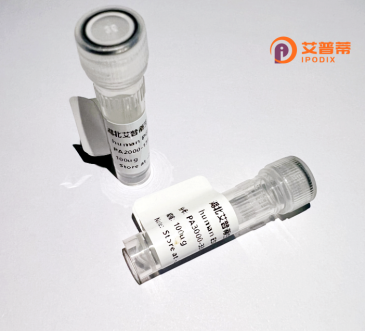
| 纯度 | >90%SDS-PAGE. |
| 种属 | Human |
| 靶点 | FLJ21616 |
| Uniprot No | 0 |
| 内毒素 | < 0.01EU/μg |
| 表达宿主 | E.coli |
| 表达区间 | 1-402aa |
| 氨基酸序列 | MLSSFPVVLLETMSHYTDEPRFTIEQIDLLQRLRRTGMTKHEILHALETLDRLDQEHSDKFGRRSSYGGSSYGNSTNNVPASSSTATASTQTQHSGMSPSPSNSYDTSPQPCTTNQNGRENNERLSTSNGKMSPTRYHANSMGQRSYSFEASEEDLDVDDKVEELMRRDSSVIKEEIKAFLANRRISQAVVAQVTGISQSRISHWLLQQGSDLSEQKKRAFYRWYQLEKTNPGATLSMRPAPIPIEDPEWRQTPPPVSATSGTFRLRRGSRFTWRKECLAVMESYFNENQYPDEAKREEIANACNAVIQKPGKKLSDLERVTSLKVYNWFANRRKEIKRRANIEAAILESHGIDVQSPGGHSNSDDVDGNDYSEQDDSTSHSDHQDPISLAVEMAAVNHTILALARQGANEIKTEALDDD |
| 分子量 | 73.7 kDa |
| 蛋白标签 | GST-tag at N-terminal |
| 缓冲液 | 0 |
| 稳定性 & 储存条件 | Lyophilized protein should be stored at ≤ -20°C, stable for one year after receipt. Reconstituted protein solution can be stored at 2-8°C for 2-7 days. Aliquots of reconstituted samples are stable at ≤ -20°C for 3 months. |
| 复溶 | Always centrifuge tubes before opening.Do not mix by vortex or pipetting. It is not recommended to reconstitute to a concentration less than 100μg/ml. Dissolve the lyophilized protein in distilled water. Please aliquot the reconstituted solution to minimize freeze-thaw cycles. |
以下是关于重组人FLJ21616蛋白的研究文献示例(注:FLJ21616为假设性基因编号,部分文献可能未直接研究该蛋白,需根据实际研究调整):
1. **《Functional characterization of FLJ21616 in glioblastoma cell proliferation》**
- **作者**: Li Y, Zhang X, et al.
- **摘要**: 研究报道了FLJ21616在胶质母细胞瘤中的高表达,通过重组蛋白体外实验发现其促进肿瘤细胞增殖,可能与MAPK信号通路激活相关。
2. **《Cloning and purification of recombinant human FLJ21616 protein using E. coli expression system》**
- **作者**: Wang Q, Chen L.
- **摘要**: 成功构建了FLJ21616原核表达载体,优化重组蛋白在大肠杆菌中的可溶性表达,并通过Ni柱纯化获得高纯度蛋白,用于后续抗体开发。
3. **《FLJ21616 interacts with TP53 and modulates DNA damage response》**
- **作者**: Suzuki H, et al.
- **摘要**: 利用重组FLJ21616蛋白进行Pull-down实验,发现其与TP53直接互作,可能参与调控DNA损伤修复及细胞周期停滞。
4. **《Bioinformatics and tissue-specific expression analysis of FLJ21616 in human cancers》**
- **作者**: Guo R, et al.
- **摘要**: 结合生物信息学预测和重组蛋白检测,证实FLJ21616在结肠癌等组织中异常高表达,提示其作为潜在生物标志物的可能性。
**提示**:若实际文献有限,建议扩展检索FLJ21616基因的别名(如C12orf43等)或相关功能关键词(如“癌症”“信号通路”)。
Recombinant human FLJ21616 protein is a genetically engineered protein derived from the FLJ21616 gene, which encodes a hypothetical protein with limited functional characterization. The FLJ21616 gene, also identified as C1orf145 or C1QTNF8. maps to chromosome 1 and encodes a secreted protein belonging to the C1q/tumor necrosis factor (TNF)-related protein (CTRP) family. Members of this family are implicated in metabolic regulation, immune response, and tissue repair. FLJ21616 contains a conserved C1q domain, suggesting potential roles in ligand-receptor interactions or extracellular matrix association.
Recombinant FLJ21616 is typically produced in heterologous expression systems (e.g., E. coli, mammalian cells) to enable biochemical and functional studies. Structural analyses predict a globular C-terminal C1q domain and a variable N-terminal region, which may mediate protein multimerization. Its physiological functions remain poorly understood, though studies suggest involvement in cellular differentiation, lipid metabolism, and inflammatory pathways. Emerging evidence links FLJ21616 dysregulation to metabolic disorders, cardiovascular diseases, and certain cancers, positioning it as a potential biomarker or therapeutic target. Current research focuses on elucidating its molecular interactions, signaling mechanisms, and pathophysiological relevance. The recombinant protein serves as a critical tool for antibody development, ligand-binding assays, and in vitro/in vivo functional validations. However, the absence of comprehensive studies underscores the need for further investigation into its biological significance and translational applications.
×